Many podcasting tools offer the ability to automatically crosspost your audio podcast to YouTube. Here are eleven reasons I think you shouldn't do that.
I often use the term “fake video” to describe what some podcasters make. It's when they take the whole audio of their episode, put it into a video file, and display a simple image (static or sometimes moving). It's essentially audio with pixel dimensions.
I think the short, animated videos commonly called “audiograms” are entirely separate and beneficial. My following thoughts address the “fake video” approach.
1. The supporting reasons are mostly misunderstood and short-term
I usually hear four reasons to publish fake video on YouTube:
- To make your content discoverable on Google and YouTube—Maybe true, at first, but it will soon be demoted.
- It's easy and maybe even automated with publishing tools—Simply because something is easy doesn't mean it's good.
- It reaches a non-podcast audience—True, but it's reaching them so ineffectively, you might not see any positive results.
- “It can't hurt”—Actually, it can hurt, as you'll understand from the following points.
2. It's abusing the platform
YouTube is a video platform. It's designed for videos. When people search or browse YouTube, they expect to watch videos. Posting fake video goes against the simple premise of video.
If someone writes a long blog post, takes a screenshot, and shares that image on Instagram, we would consider that abusing the platform.
If someone makes a blank image and uploads to Instagram only so they can write a long blog post, we would consider that abusing the platform.
If someone releases a series of silent podcast episodes only so they can put out the titles in podcast apps, we would consider that abusing the platform.
And if someone publishes only audio, but no video, on a video-based platform, we should also consider that abusing the platform.
This is not an effective technique for sharing content appropriate to the platform. This is more like a blackhat hack with a bait and switch.
3. The “view” stats are meaningless
If you publish fake video, or you see other fake videos, you may initially think it's a success because of the view counts. But like “downloads per time,” view counts don't tell the whole story and are a meaningless stat.
Social networks count something as a “view” after different amounts of time. YouTube seems to have a 30-second threshold. So someone could watch a video for only 30 seconds, and it would be counted as a view. But if your video is as short as a few minutes or much longer, only 30 seconds is meaningless to actual consumption.
Think of it as a local store. The way YouTube and other social networks work, they would count you as a customer every time you drive by and look at the store. But were you really a customer if you didn't at least go inside?
Contrast that with the nature of podcast downloads and consumption. This is more like counting everyone who entered the store. True, maybe not everyone stays in for long or even buys anything at all, but they were still a customer by entering and behaving like a customer.
I've seen data on some fake videos that seemed highly successful: as many as nearly 23,000 views on one video! But the real truth is in the retention stats.
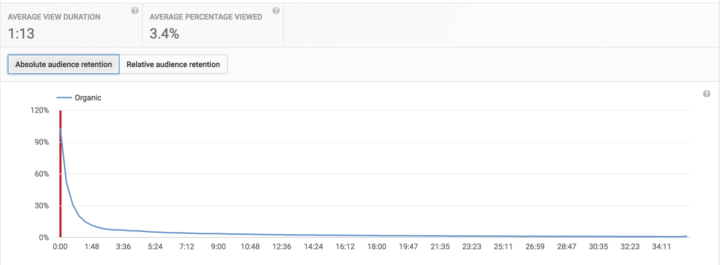
Only a 3.4% average view duration. 90% of the initially 23,000 viewers were gone within 90 seconds!
All data I've seen, from multiple sources, show that most fake videos lose 90–95% of the audience within only 90 seconds! Interestingly, this does seem to differ among countries. But that makes sense, considering that podcast consumption is not as popular or possible in some other countries.
You might think that later videos, which averaged about 200 views, had filtered down to loyal fake-video consumers. Retention rates were, indeed, better. This time, it took only about 4 minutes for 85–90% of the “loyal” audience to abandon the videos!
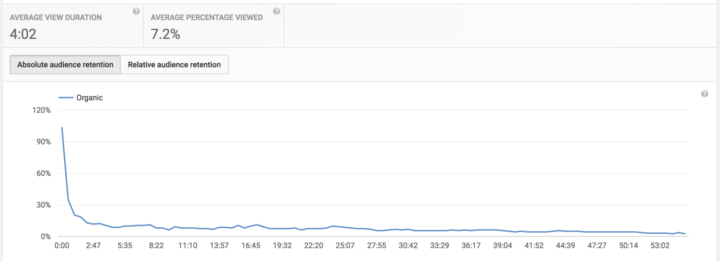
Retention stats on a later video with 175 views.
The resulting audience who did stay to consume the majority of the video ended up being only 6–8% of the view count. Thus, only about 16 people benefitted from the video. That's 16 out of an initial audience of nearly 23,000!
4. Engagement rates are horrible
If you dismiss the meaningless view counts, you must measure other forms of engagement: retention, likes, comments, subscriptions, clickthroughs, and shares are common metrics on YouTube.
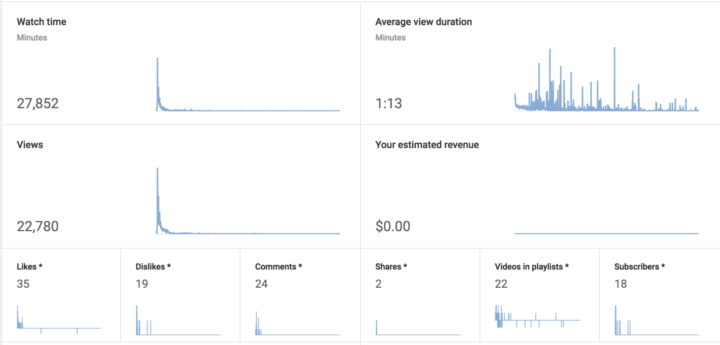
A video with nearly 23,000 views received only 35 likes, 24 comments, 2 shares, 18 subscribers, and 19 dislikes.
Fake videos show horrible engagement in all these metrics. I've seen videos with more than 20,000 “views” receive only a few likes, subscriptions, and no comments. This shouldn't be surprising when you consider that almost all the audience is gone within a few minutes. But even of the small number of remaining viewers, they still don't engage with the fake video.
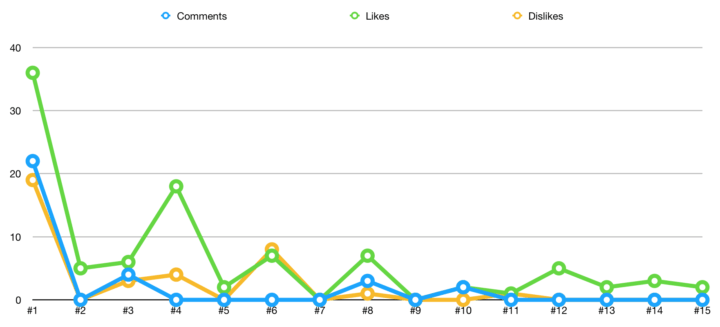
Comment, like, and dislike engagement rates are almost nonexistent compared to the supposed view counts.
5. Your channel's and videos' rankings will be demoted
The top reason I hear people advocate for fake videos is that they make the content show up in search rankings. That may be true at first, but it doesn't last. Furthermore, the consequences can prevent future videos from ever ranking.
YouTube, which is owned by Google, uses several factors to measure a video's popularity and thus rank it in search results. They use all those same engagement metrics:
- Retention—if most people quickly abandon the video, it's probably not worth ranking
- Likes and comments—if no one is interacting with the video comments, it's probably not worth ranking
- Subscriptions—if no one is subscribing to the channel as a result of the video, it's probably not worth ranking
- Clickthroughs—if no one is clicking through to other videos and staying engaged on YouTube, the video is probably not worth ranking
Fake videos perform notoriously low on all these metrics. Consequently, Google's algorithms will consider the video a waste and demote it in the rankings. After all, if almost everyone else doesn't like it, why would they recommend it to others?
Could you imagine my recommending a doctor by saying, “No one ever sees him, and he's not a very good doctor anyway”?
6. YouTube doesn't like your making people leave
Google wants people to stay on YouTube. It's easy to waste hours and hours on YouTube because it was designed with exactly the scientifically proven tactics to get you to stay! Even when I was preparing this episode, I got sucked into watching video after video (real videos!).
YouTube won't like it when you make people leave YouTube, either by closing the browser tab or by following a link that takes them away from YouTube. Such links might be to your website or your podcast in a podcast app. They'll either demote your video or sometimes even find other ways you might be violating their community guidelines.
7. Content ID gives content owners control over your videos
When you upload a video with any copyrighted material (regardless of your use), YouTube's advanced bots will recognize and flag it with Content ID. The copyright-holder can then control many things about your video:
- Keep your monetization (or share it, if they're generous)
- Block the video from some countries or worldwide
- Block the video from certain platforms (such as mobile or embedded)
- Mute the video
I've seen many legitimate videos get flagged by Content ID, such as a movie-review podcast that comments on and plays a portion of the movie or soundtrack.
You can dispute a Content ID claim, but failing that could lead to even bigger consequences.
8. Copyright strikes are aggressive
In extreme cases, your videos could give your channel a copyright strike. This usually means the video will be removed and you'll carry a strike on your account, which might limit features (such as monetization or live-streaming). Further abuses will usually result in a complete closure of your account.
9. Monetization may be limited
YouTube is a monetized platform. They don't really like it when you monetize your own content without letting them have a piece of it. Podcast sponsorships, promoting your own products, and affiliate links can be in this gray area. YouTube has already cracked down on this kind of monetization when a product or logo is displayed as a paid advertisement.
Regardless of how you monetize your own podcast, YouTube can decide to ban it from YouTube at any time if they decide it's not in compliance with their standards.
10. YouTube may flag your fake videos as spam
Most fake videos look the same. Usually, that's simply the cover art. Sometimes, it contains “buttons” or calls to action.
When YouTube sees multiple videos being uploaded regularly and they all look the same, their algorithms have often flagged this as spam. But I'm not surprised because it really does look like spam!
Video, channel, and comment spam
It's not okay to post large amounts of untargeted, unwanted, or repetitive content in videos, comments, private messages, or other places on the site. If the main purpose of your content is to drive people off of YouTube and onto another site, it will likely violate our spam policies.
It's not okay to post large amounts of repetitive and/or re-uploaded videos to your channel. If the main purpose of your channel is to monetize other channels' content, it will likely violate our spam policies. If you believe your copyright-protected work was posted on YouTube without authorization, you may submit a copyright infringement notification.
[“Spam, deceptive practices & scams,” YouTube.com, emphasis added]
11. It makes your channel the little boy who cried, “WOLF!”
Each time you publish audio on a video platform, it's misleading your potential audience. As more and more of your fake videos show up in search results, they'll learn to not trust your channel. It's like the boy who cried, “WOLF!”
I've seen this with some experimental channels. With each fake video released, the view counts and retention get worse and worse. Then, the ranking starts to fall because of all the other metrics.
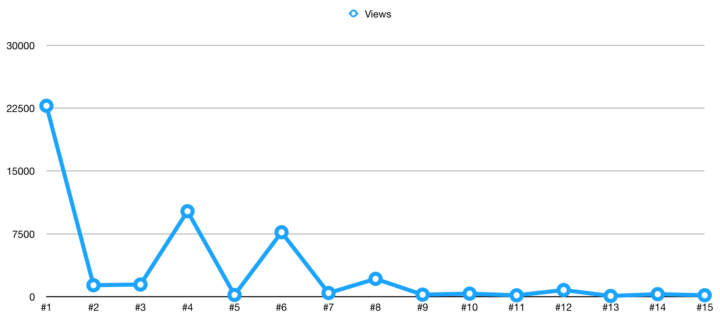
Absolute view counts of the first 15 audio episodes published on YouTube show significant dropoff after the initial attention
So if you ever want to do a real video on your video channel, publishing fake videos will have demoted your channel so much that your real video may never receive attention.
Conclusion: Publish fake videos if you don't actually care
There are better ways to use YouTube with podcasting (episode 186). You can live-stream, make video promos, make specialized video content, make short snippet animations or videos, and more.
If you really don't care about the YouTube platform and don't care much about its users, then go ahead and publish fake videos. But keep in mind the potential consequences, costs, and extremely low return on your investment (time, skill, or money).
Thank you for the podcast reviews!
- nabus19, from the USA and host of The Redrum Theatre, wrote in Apple Podcasts, “High Five Brother. I love podcasts, and have enjoyed them as a media for 10 years now. Recently I began my own, and I was looking for some wisdom in doing this well. Of all the How-To podcasts I listened to, this is the only one to survive. Great topics, current issues of podcasting, and real knowledge from a professional podcaster. I especially love when he used to review a podcast and give some helpful tips. Bring it back brother! My podcast is called The Redrum Theatre, … We watch movies, we love movies, we were raised by movies.”
- Covert Nerd, from the USA and host of Covert Nerd podcast, wrote in Apple Podcasts, “… Because of you I have stepped out and started a hobby podcast. Right now it isn't that good, but because of you I got the courage to at least start. I am sure many others have done the same thing because of your work. I would encourage other like you do to just start your podcast and you can work out the details as you go. …” Read the full review.
Your reviews encourage me and they help other people find the podcast.
If you appreciate the podcasting information I share, please write your own review on Apple Podcasts, Podchaser or Stitcher!
Need personalized podcasting help?
I no longer offer one-on-one consulting outside of Podcasters' Society, but
request a consultant here and I'll connect you with someone I trust to help you launch or improve your podcast.Ask your questions or share your feedback
- Comment on the shownotes
- Leave a voicemail at (903) 231-2221
- Email feedback@TheAudacitytoPodcast.com (audio files welcome)
Connect with me
- Subscribe to The Audacity to Podcast on Apple Podcasts or on Android.
- Join the Facebook Page and watch live podcasting Q&A on Mondays at 2pm (ET)
- Subscribe on YouTube for video reviews, Q&A, and more
- Follow @theDanielJLewis
Disclosure
This post may contain links to products or services with which I have an affiliate relationship and
may receive compensation from your actions through such links. However, I don't let that corrupt my perspective and I don't recommend only affiliates.


